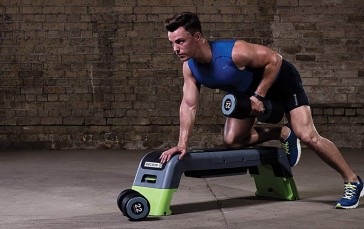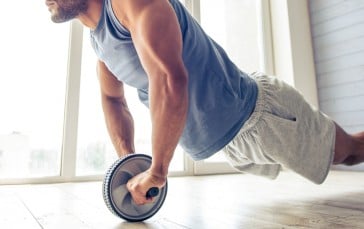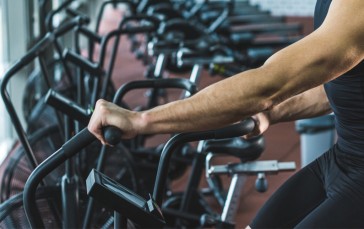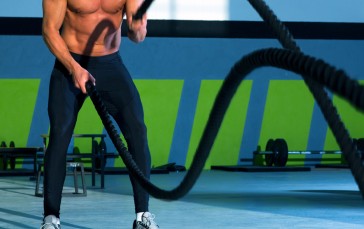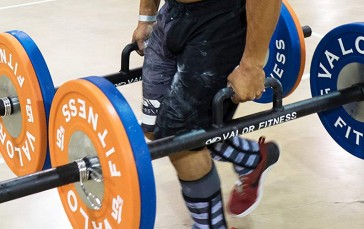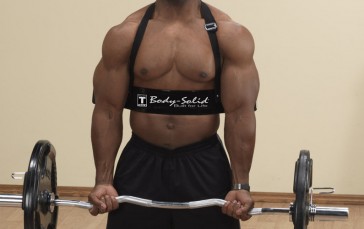How To Increase Muscle Definition
When you look in the gym mirror do you see a totally chiseled bod or is it still a work in progress? Despite all your weightlifting and body power pumping efforts, perhaps you’re not seeing the sculpted shape you have been working so hard for and are not sure why.
Spending time at the rack lifting ankle and wrist weights or pounding the treadmill to torch the body fat is no guarantee for a ripped body. In fact, your workout routine could actually be sabotaging your lean and mean dreams. Bulking up is actually a fine-balance between pumping iron, high-intensity cardio and eating right for muscle gain. Get it out of synch and you could be putting in the workout hours without the muscle guns to show for it.
If your bodybuilding sessions are falling short when it comes to getting pumped, then Gear Hungry is here to help, with our top tips guide to increasing your muscle definition. Get prepared to take your physique to the next level of lean….

1. Get your diet right
When it comes to increasing your muscle definition, your diet plays a key role in three ways – to help you effectively build muscle, fuel your powered workouts and to help you to shred body fat so that your newly-honed lean muscle can shine through.
For health in general, a balanced diet is essential but when it comes to packing on the lean, it’s also what, how and when you eat that can make all the difference in achieving that ultimate muscled look. To provide your body with all the fuel it needs to get totally ripped you should:
Eat high-quality protein
Protein as we all know is the building block to our muscles and when it comes to healthily creating the lean and mean, then the best quality protein is the way to go. Quick science time: the more protein your body is able to store via a process called protein synthesis, the larger your muscles are able to grow, with a little help from your powered routine of course. However, your muscle building workouts are also competing with other demands from your body for protein, such as making hormones and repairing tissue, so you need to eat sufficient quantities to ensure there’s enough to go around.
Eggs, lean meat (chicken or beef), milk, fish, beans, nuts, and pulses are all great go-to protein sources, as well as protein powders and protein shakes for when you are on the go. Eating more protein can also help with fat loss, as well as making you feel fuller for longer, so it’s a total muscle-building win-win.
Carb-power your post workouts with carbs
Instead of shunning the carb, you should make it work to your muscle-building advantage – cutting out carbohydrates altogether will only bring on fatigue. But we’re talking healthy complex carbs here, so this is not an excuse to double up on the pizza and fries!
The key to carb-power is when you eat them. Making carbs part of your post-workout meal will help you to rebuild muscle faster by fueling your body and increasing your insulin levels, which will, in turn, slow the rate at which protein is broken down. Brown rice, whole grains, oats, fruit, and vegetables are all your healthy carb buddies. Or if time is tight, grab a banana or peanut butter sandwich post-workout to keep you and your muscles sufficiently fueled.
Eat enough calories
A lack of calories will simply hold back muscle growth as under pressure from your workout they need the energy to gain more bulk. Make sure you are eating enough calories a day – and this includes healthy fats as well as carbs and protein – to support your muscle loading, without adding to your body fat.
‘Calorie cycling’ is a good way to go if you want to build muscle as well as lose or maintain weight: this simply means consuming more food on your training days, ensuring you remain hydrated throughout. And finally, eat at frequent intervals (experts suggest every three hours) to keep your body – and muscles – firing on all cylinders. So make sure you include healthy snacks and rich meals.

2. Prioritize your powerlifting
If you have only just started working on your muscle definition, then an all-around workout will be intense enough to build more muscle. But if you’ve been powerlifting for some time, then the way to build more muscle quicker is to focus on your large muscle groups, such as the chest or legs.
To get those muscles concrete solid, you need to go hard on your powerlifting with heavier weights to make this the main man in your muscle definition workout plan. But don’t forget, it’s how you configure your lifting workout that will help you to really pack on the lean muscle.
For super muscle definition, less is more when it comes to pumping reps at the squat rack. Instead of stepping up to the weight bar or adjustable dumbbells and rapid-firing through a higher number of reps using lighter weights, the secret is to slow down and lift more.
With higher reps and a lightweight, you will increase your muscles’ endurance but not bulk. However, keep those reps within the six – 12 range using a heavier, more challenging weight and you will promote a muscle response in terms of both size and strength. Increasing the weight with fewer reps will also test those fledgling muscles as you will be using a progressive overload to increase tension. And that is exactly what you want to give your muscles a reason to get bulked!
Maximizing this tension with an effective lifting technique will really turbo-boost your muscle’s definition and size. One good way to do this is making the stretch of the lift – when your muscle stretches away from you under the weight – count as much as the contraction (when you contract the muscle back towards your body). You can also count down the stretch and make it a few beats longer than the contraction. You’ll certainly feel the muscle burn but also see the results – try it!
And don’t get stuck in a rut with free weights or at the gym’s squat racks. Shake your powerlifting up by adding deadlifts, kettlebells, push-ups, bench presses and dips to your workout, keeping to the stretch and contraction principle to make those muscle bad boys work hard.
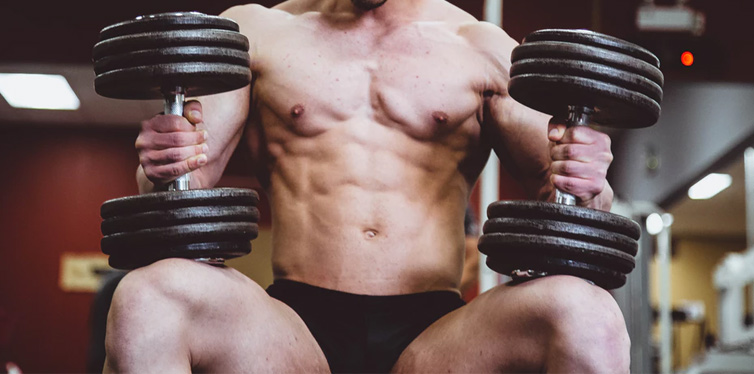
3. Don’t go too heavy on the cardio
If you want to keep whittling away at that chiseled muscle outline, then make sure you don’t go too hard on the cardio. Incorporating excessive amounts of cardio exercise into your weekly routine could mean you lose some of your hard-earned muscle as well as any fat you are trying to burn.
Cardio is effective if you are trying to lose body fat (and less body fat means more of your lean, mean, muscle-ripped machine is seen) but there’s a balance to be had. To help protect your freshly pumped muscle while also still getting your cardio hit, go down the resistance training route. Resistance or high-intensity interval training (HIIT) will not only help to burn fat but done effectively, can also help to fine-tune your muscle building.
To maximize on the benefits of each type of workout, try to keep your weightlifting and cardio sessions on separate days to minimize any negative impact from the cardio on your most recent muscle gains and to allow your body to recover in-between.
Your cardio sessions don’t have to be long-winded affairs, just go all out with the resistance training over a 20-30 minute total workout. And they certainly don’t have to be complicated. Short, super-fast bursts on the assault bike or treadmill will get the heart pumping; throw in fast gradient changes too and you will certainly feel it! You are also welcome to use resistance bands. Battle ropes are fantastic for getting a power-charged HIIT, too, working the upper body as well as pushing the cardio, while medicine balls are a top challenge for bringing on an iron-strong core.
While focusing on building muscle, make your weightlifting sessions your priority, and try to keep your cardio to 2-3 times a week to ensure your ripped goals are heading in the right direction.
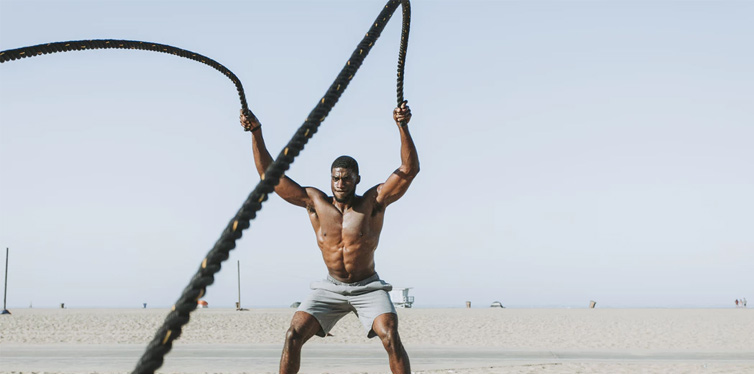
4. Get into the right routine
So, you have the right diet, the best powerlifting workout, and the cardio sessions sorted, that’s you on a one-way trip to muscle-ville right? Well, probably but you don’t want to take anything for granted. How you schedule your muscle defining strategy will get you a first-class ticket upgrade to your lean and mean final destination.
It’s tempting, particularly when you see those guns starting to bulge, to go too hard on the frequency of your weightlifting sessions, putting you at risk of undoing all that hard work. Ideally, you should be putting in the sweat at the squat rack for a quality session, three to four times a week, with a day’s break in-between as your muscles, need 48 hours to rest.
Intense activity needs this recovery time, particularly if you are focusing on the same muscle groups each session. If you work them every day, you could find you are undoing any gains as you may get sore muscles that become fatigued and the workout less effective. Think quality rather than quantity when it comes to your powerlifting and muscle building, and make sure you properly recover from the workout.
Keeping your cardio or HIIT sessions on separate days also allows sufficient muscle recovery time, and lets your body concentrate on bulk-building your frame.
Your cardio hit is to keep your body fat lean and enhance muscle definition and your routine can actually be boosted by when you do it. Go hard on your interval training first thing in the morning, before breakfast and your short, sharp sessions will have maximum impact. Also, avoid high impact cardio workouts such as jump rope or running on hard surfaces that can cause microtrauma – small tears in the muscle fibers that are needed for building new muscle.
And, if at times your busy life means you simply can’t avoid doubling up your lifting session with cardio at the gym, then do your power lift first so you and your muscles can go at it fresh.

5. Rest and reduce stress
If you’re serious about increasing your muscle definition, a few simple steps before and after your sessions will keep you totally on muscle-building track and injury-free.
It’s essential to warm up for weightlifting and stretch out after every session as your muscles will need help to prepare, adjust and recover after some hardcore squat rack, free weight or dumbbell exercise. Begin every weightlifting and cardio session with at least five minutes of warm-ups, including low-intensity cardio and some stretches of the muscles you plan to target. Then, once the hard work is done, slowly stretch out all your muscles to cool them down before you call it a day and head off to the showers.
Rest is certainly your friend when it comes to packing on the muscle: disregard your body’s need for recovery after a grueling workout and you’ll eventually find your bodybuilding wins grind to a halt. Taking a day off in-between power sessions allows your glycogen energy stores to build back up, lets those new muscle fibers to settle and enables hormones such as testosterone and cortisol which can increase during a full-on powerlifting session return to their optimum level. In short, your body gets rebooted, ready to take on another muscle-defining session.
But the key to packing on lean muscle is not just rest days but also quality rest nights too. By intensively working out, you have stimulated muscle growth, but you build your muscle during rest, which means a good night’s sleep gives your body the time and space it needs to knit that new, ripped muscle into place.
And finally, the last piece in the jigsaw to improving muscle definition is to keep your cool. Stress kickstarts the release of cortisol. Too much and the hormone can start to put the brakes on your muscle-sculpting efforts so make sure you relieve stress and go to your workouts calm and in the right frame of mind. Then relax once the hard work is done, and you are one more step towards the totally chiseled, muscular frame you have set your determined sights on.


